Top 10 music movies
From wild-haired rockers to joyful bolero singers, films with or about celebrated musicians have played a key part in the movies. Here, the Guardian and Observers' critics pick the 10 finest
• Top 10 silent movies
• Top 10 sports movies
• Top 10 film noir
• Top 10 musicals
• Top 10 martial arts movies
• Top 10 biopics
• More Guardian and Observer critics' top 10s
10. Don't Look Back
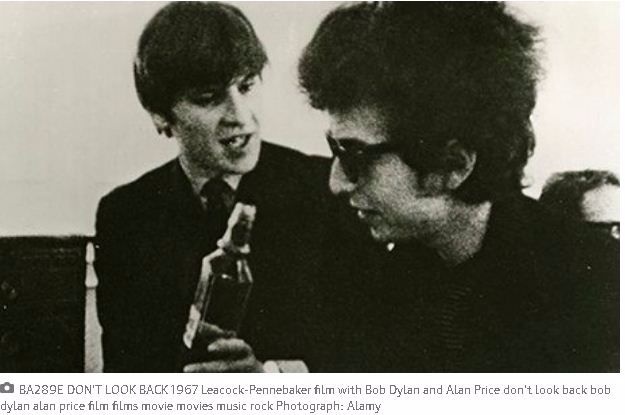
DA Pennebaker's 1967 documentary is significant because it may be the first serious attempt to show what was actually happening in rock'n'roll as it struggled to find maturity. The film follows Bob Dylan on his 1965 tour of England – just a year before the famous one, in which he affronted his traditional folk audience by plugging in his guitar – which proved to be a watershed period in his life, resulting in his being heckled at the Free Trade Hall in Manchester with the sanctimonious one-liner "Judas!".
By then, though, Dylan didn't much care, and, if nothing else, the film proves it. Pennebaker has said since that the title came from African-American baseball player Satchel Paige, who once said, "Don't look back. Something might be gaining on you." This would appear to be Dylan's philosophy of the time: out was the fresh-faced folkie look, replaced by leather and shades and a spidery, speed-freak demeanour. Gone too were the camaraderies of the old folk scene; what shocked audiences when the film was first released was Dylan's bite-the-hand-that-feeds attitude, not simply to his audiences but also the press, whom he treated with arrogance and contempt.
Seen now, the film is a perfect time capsule, practically the big bang of modern rock. Through Pennebaker's film we see for the first time the machinations of an artist who knows he has to destroy his past to create a future – something the Beatles did in a more passive-aggressive way by refusing to tour – but we also see the start of the bemused media's attempt to co-opt and contain a youth movement that is growing and evolving by the minute. The proto-music video clip that shows Dylan dismissively holding up the lyrics to Subterranean Homesick Blues behind the Savoy hotel has become its MTV legacy, but in reality Don't Look Back is about much more than that – it is about the making of a modern rock star, a role Dylan obligingly played to perfection. Damon Wise
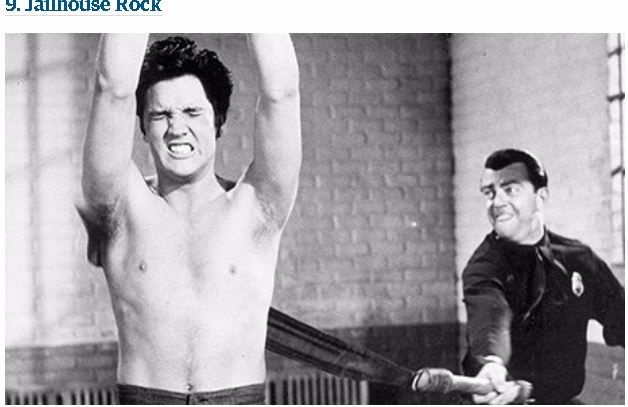
The spoiling of a raw but provincial and naive talent – fleeced by cheating managers and ruined by the toxic side-effects of fame – has been the backbone of the rock'n'roll movie ever since, but Jailhouse Rock, only Elvis Presley's third movie as an actor, after the soporific Love Me Tender and Loving You, still gives a jolt. Starring Presley as Vince Everett, a short-fused construction worker jailed for manslaughter after defending himself in a bar brawl, the film is a particular favourite of Quentin Tarantino, who penned the ultimate tribute to it in his script for True Romance. "In Jailhouse Rock," says Clarence Worley, "[Elvis] was everything rockabilly's about. I mean, he is rockabilly. Mean, surly, nasty, rude. In that movie he couldn't give a fuck about nothing except rockin' and rollin', living fast, dying young and leaving a good-looking corpse."
That the film was made by 61-year-old Richard Thorpe, a mostly unremarkable director for hire since the silent era, is especially fascinating, since the film not only nails the dangerous allure of rock'n'roll – Vince frequently loses his temper in self-destructive situations – it completely captures the generation gap that it caused. On the one hand there is Hank Houghton (Mickey Shaughnessy), Vince's prison mentor who sings clapped-out country and western, and on the other there is the sophisticated social circle of the film's love interest, Peggy Van Alden (Judy Tyler). One incredible scene finds Peggy taking Vince to a middle-class party, where the talk is of jazz and a lady who lunches describes atonality as a passing phase. "What do you think, Mr Everett?" Presley's dead-eyed retort is the film in a nutshell: "Lady, I don't know what the hell you talkin' about." DW

It would be difficult to overestimate the influence and importance of John Travolta and Saturday Night Fever on images of masculinity in cinema. From the moment we first clap eyes on him, as disco wide-boy Tony Manero, strutting through the Brooklyn streets to the sounds of the Bee Gees' Stayin' Alive, he owns the screen and the movie. As much as Robert De Niro, John Wayne or Steve McQueen, Travolta represented both a celebration of male arrogance and inarticulacy – and a pitiless analysis of it. As Tony, he is lovably cocksure, but prone to an emotional volatility that can be revealed at the drop of a stylus on vinyl. His passion for disco, and the tenderness with which he approaches his evenings on the glowing dancefloor (with the intensive grooming regime this entails), is strangely ennobling. It's away from the disco that his troubles accumulate.
John Badham was brought in after disagreements between John G Avildsen, the Oscar-winning director of Rocky, and the film's producer, Robert Stigwood. Badham's main accomplishment is to keep the camera on his star, fill our ears with the vivid and electrifying soundtrack and evoke Tony's love-hate relationship with the grimy vitality of Brooklyn; the dance contest that he enters with his similarly restless girlfriend Stephanie (Karen Lynn Gorney) becomes a crucible for his dreams, but also a focus for the injustices that persist beyond the disco walls. There's a playful rapport between the two lovers that gives Travolta ample opportunity to flash his insouciant grin. ("Nice move, did you make it up?" asks Stephanie admiringly. "Yeah, well I saw it on TV first," Tony shrugs, "then I made it up.") The actor quickly became a byword for bad career choices and squandered potential, but Saturday Night Fever alone is enough to ensure his place in cinema history. Ryan Gilbey
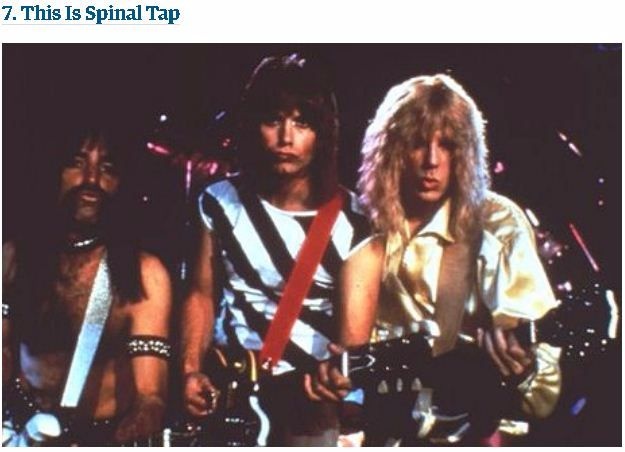
A rock mockumentary important enough to be selected for preservation in the US Library of Congress, This Is Spinal Tap is one of the all-time greats, and its influence looms large to this day. Ostensibly following a semi-forgotten rock band's comeback tour, Tap manages to hit so many targets – the labyrinthine backstage corridors, the onstage mishaps, the unwanted influence of a resident Yoko Ono figure – that several real-life rockers admit that they struggle to find the humour in it. But their loss is everyone else's gain.
Even if you haven't seen This Is Spinal Tap, you know about it (there's a reason why the BBC iPlayer volume switch goes up to 11), and you've probably been quoting it for years. Shriekingly funny, full of standout performances and containing some of the best parody songs you're ever likely to hear, This Is Spinal Tap is so much better than you could ever expect from a film starring Harry Shearer (the voice of Ned Flanders), and Baron Haden-Guest. Stuart Heritage
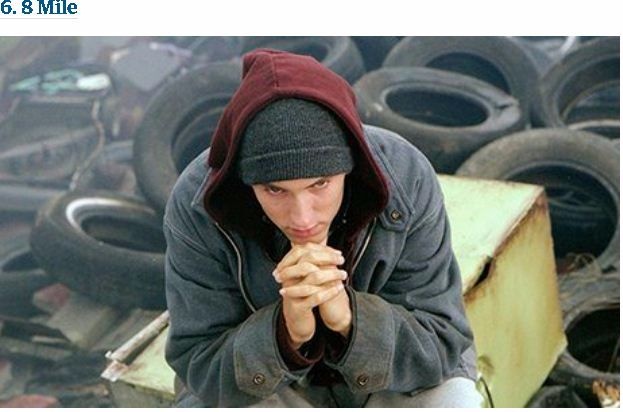
John Ford once opined that it was easier to teach an actor to ride than a cowboy to act. He never made a musical and thus remained silent on the issue of whether it is easier to teach an actor to sing than a singer to act. Rap artists, like opera singers, are engaged in a kind of dramatic performance and have made the transition quite naturally in movies that reflect the conflicts of the black ghettos that inspire their numbers - one thinks of Ice Cube in in Boyz N the Hood and and the late Tupac Shakur in Gridlock'd. Eminem is fortunate to make his movie debut in 8 Mile.
The film was shot in Eminem's native Detroit, the most rundown of America's great cities, in steady decline since the appalling riots of 36 years ago. The title refers to the Eight Mile Road, the perimeter that divides the dangerous, neglected inner city, home to poor whites and deprived blacks where Eminem was reared, from the relatively well-off suburbs where the middle classes reside in closely guarded estates. Rodrigo Prieto, the brilliant Mexican photographer who shot Amores Perros, turns a remorseless eye on the decaying Detroit where Eminem's character, Jimmy "Rabbit" Smith, lives with his feckless, low-life mother (Kim Basinger), her four-year-old daughter, and her seedy lover Greg, a high-school contemporary of Jimmy's.
Almost everything in the film points towards semi-autobiography: the absent father, the uneasy relationships with a wayward mother, a rejected girlfriend and a new lover; his hanging out with a multiracial crew (presumably forged in high school) dedicated to each other's welfare and, above all, the expressive gifts as a rap performer that arise from his specific social situation the way that the blues came out of slavery and its aftermath, and country music arose from the condition of poor Southern whites.
The film 8 Mile most obviously brings to mind is Saturday Night Fever, a tough movie written by an old-time socialist, Norman Wexler, and resembling in tone and texture Hubert Selby Jr's Last Exit to Brooklyn until it was bowdlerised and reissued in a version that John Travolta's teenybopper fans could see. Philip French
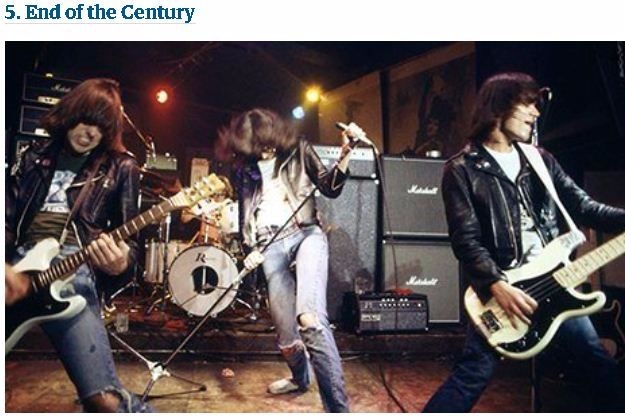
Despite the fact that End of the Century documents the makers of some of the most infectiously ecstatic, amphetamine-fun music of all time, no punk rock fan could watch it now without a creeping sense of melancholy. Here are interviews with all the major players: gentle Joey Ramone (dead by 2001), rambunctious Dee Dee Ramone (who died while the film was being made), and gloriously cussed Johnny Ramone (dead the year after it was released), as well as The Clash's Joe Strummer, who went to the big Roundhouse in the Sky in 2002. Even CBGB, the Bowery venue where they first claimed fame, is no more and the subject of its own rock doc. Some still living – founder drummer and producer Tommy, his replacement Marky, his replacement Richie, erstwhile bassist CJ – are also present and correct, contributing to directors Jim Fields and Michael Gramaglia's solid 4/4 band documentary.
Advertisement
It's a track-marks-and-all history, that while celebrating the band's vitality, innovation, and huge influence (a savvy map montage illustrates how one early tour inspired and seeded groups like the Dead Kennedys and The Cramps across the country), it never shies from showing the dark side. Coverage is given to Dee Dee's rent boy days, the drugs no rock doc is complete without, and how Joey and Johnny fell out with each other so badly the latter didn't even go to Joey's funeral. There's even material on their fraught collaboration with Phil Spector for the album that gives the film its name, when he brandished guns to force them to stay on partying.
But the strength of the film lies in its quietly authoritative assessment of their skills as performers and musicians, despite the three-chord austerity of the tunes, and how despite their different personalities the core three clicked in place together just enough to produce classics like Sheena Is a Punk Rocker, Blitzkrieg Bop, and I Wanna Be Sedated. Best of all, it's such an absorbing enough story even non-fans find themselves entranced by this history-sweeping account of irascible figures, record-industry ups and downs, and bowl haircuts. Leslie Felperin.

It could be convincingly argued that this documentary about elderly Cuban musicians whom composer-performer Ry Cooder assembled into a super-group in 1997 still represents the best thing German director Wim Wenders has made since his New German Cinema glory days in the 1970s; or, if you're feeling more generous, his last truly good feature film, Wings of Desire (1987). It's certainly one of his most influential films. Shot on digital, a massive novelty at the time, its jittery handheld aesthetic, bleached-out-in-post colour range, and understated mix of atmospheric observational anecdotes intercut with slabs of unmediated concert and performance footage have become such music-doc clichés it's easy to forget that they were fresh once. This is the film that invented them.
What's more, this in many ways is also the movie, a huge unexpected arthouse hit, that first introduced many people to world music, enticed thousands of tourists to Cuba in search of vintage cars, charming old Communist duffers and swinging parties, and launched scads of follow-up albums. No doubt many a middle-class dinner party was soundtracked by its sultry mix of mambos, boleros and cha-chas.
But, man, the music really is great. The sequence where Ibrahim Ferrer, the once-famous bolero singer whom Cooder found shining shoes in the street, sings Silencio with Omara Portuondo, is a neck-shiverer of the highest order, a moment made all the more tender by their almost-fragile voices, showing off a mastery of phrasing that only comes with age and experience. Ruben Gonzalez's darting, elegant piano solo represents another showstopper.
Meanwhile, it's impossible not to be seduced by the laid-back, amused vibe as the camera follows cigar-puffing Compay Segundo around town in search of the titular dancehall, or be charmed by his hopes to father, as a nonagenarian, a sixth child. The scene where the members wander around New York awestruck by capitalism feels a little staged and gimcrack, but it's but a fleeting duff moment in an otherwise enchanting work. LF
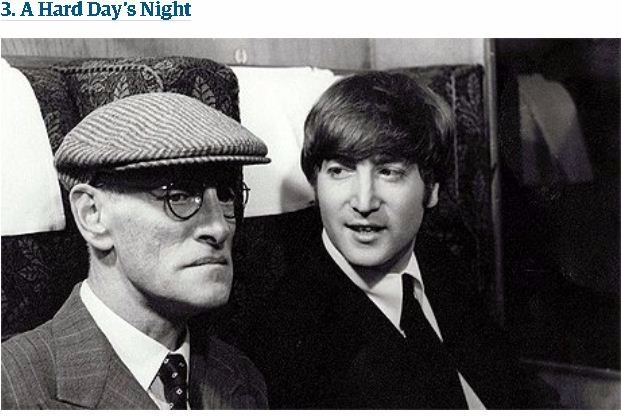
That Hard Day's Night should still be a movie milestone 50 years after it was first released is astounding, since it was conceived as a $150,000 loss-leader that would recoup its budget from US album sales. Directed by a jazz fan, Richard Lester, who was approved of by its subjects because of his close ties with the stars of BBC radio's comedy series The Goon Show, the first Beatles movie only had one proviso: that it had to be in cinemas before Beatlemania died an inevitable death. "We started shooting in March 1964 and had to be in the cinema by July 7, because United Artists genuinely thought the Beatles would be a spent force by then," said Lester.
Advertisement
TV writers Johnny Speight and Galton and Simpson were considered but unavailable, so Lester turned to Liverpool screenwriter Alun Owen, who was inspired by the band's description of their quotidian routine as "a train, and a room, and a car, and a room, and a room" to make the film "an exaggerated day in the life of the Beatles". With no plot to speak of – the band travel from Liverpool to London to film a TV show – Lester was able to focus on character, developing the variously sarcastic and playful personas that had been adopted by the band in recent months.
More importantly, perhaps, he created some striking musical set-pieces in a way that hadn't been done before. Chief among these is a scene in the baggage car of a train: the band are enjoying a respite from their fans, playing cards, watched by Paul's "grandfather" (Wilfred Bramble), when almost imperceptibly the moment segues into the lip-synched song I Should Have Known Better… and the modern music video is born. Said Lester, "I like to think it was the first time that had happened so casually on film – a development from the Stanley Donen musicals, like On the Town or Singin' in the Rain, which had dream sequences and gave you that sense of being in two realities at once." DW
2. Control
 emblazoned on the back.
emblazoned on the back.
But Control doesn't leave its subject's sombre mythology entirely unchecked. Corbijn and his screenwriter, Matt Greenhalgh (adapting the book Touching From a Distance by Curtis's widow, Deborah), recognise that this story has elements of the gloomy but dryly funny kitchen-sink films of the 1950s and 1960s, and have fashioned their picture accordingly. That means you get something you wouldn't expect — laughter amidst the darkness. Most of the humour comes courtesy of Rob Gretton (Toby Kebbell), who delivers a monologue (littered with a c-word that isn't "control") outlining why he should manage the band. By this time, Curtis is married to Debbie (Samantha Morton) and chafing against domesticity. Add to this his epilepsy and depression, the pressures of Joy Division's success, and an affair with the journalist Annik Honoré (Alexandra Maria Lara), and you can see why he was never going to be Manchester's answer to Sacha Distel.
The film takes its time cataloguing the singer's indecisive shuttling between Debbie and Annik, but then it would be hard to convey the intensity of his brief life without this degree of scrutiny, or performances as heartfelt as those of Morton and Riley (who also does his own singing). Lara fares less well in the sketchier role of Annik but, in her favour, she delivers the immortal line "Tell me about Macclesfield" in a Belgian drawl without wincing. A few of Corbijn's touches, such as the illuminated Sex Pistols marquee that fizzles out the moment Joy Division is formed, are straight from The Beginner's Guide to Biopics. What distinguishes the film is its skill in balancing both the public version of Curtis and the private one this concealed. RG
1. Dig!
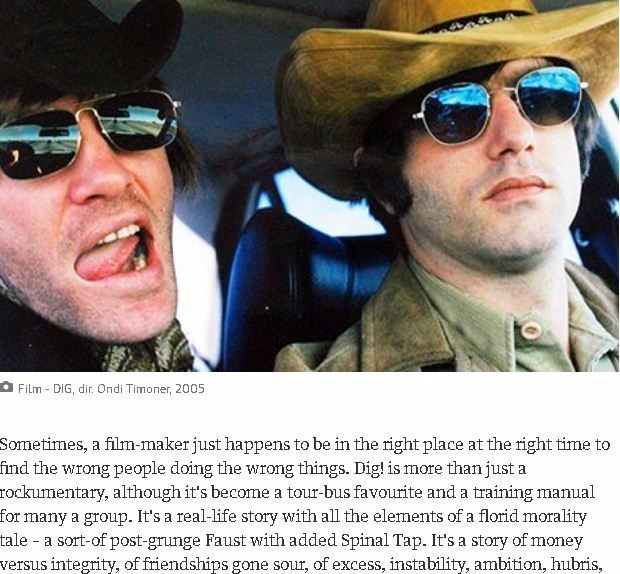
and every other rock'n'roll lesson that people thankfully never learn because there wouldn't be any rock'n'roll if they did.
Advertisement
The two bands at the heart of Dig! – the Dandy Warhols and the Brian Jonestown Massacre – are almost footnotes now, to the extent that the film itself could be what they're best remembered for. But when we first meet them, though, they're preparing for the big time. They're rock stars in waiting: two bands at the tip of a 60s-influenced garage/psychedelic sound that's about to go mainstream, with two charismatic but flawed frontmen. They love each other's music, they play onstage together, they party offstage together, and they're here to "start the revolution". When their fortunes diverge, though, that friendship and mutual respect turns into something else.
BJM's Anton Newcombe is the wildman of the piece. He's either a talented, prolific genius or an egotist with mental health issues, depending on how you see it. Despite his projected stardom, Newcombe seems to screw up every break the band gets. That leads to a hilarious "industry showcase" during which he insults the audience, demands a drink, announces the next song is "about love", then gets into a messy onstage brawl with his band members, before the bouncers eject him. "They fuckin' broke my sitar, man," he moans, out on the street.
The Dandy Warhols' Courtney Taylor, who narrates the film, admits to being less talented than Newcombe (if no less an egotist), but he's more privileged, better adjusted and cannier professionally. Thus, the Dandies get the major-label recording contract, enter the industry and proceed to sell their heroin-chic souls – particularly in the eyes of the BJM, who turn up to the Dandies' big-budget video shoot to sneer at the dancing syringes and steal the sandwiches. In return, the Dandies audaciously crash the BJM's scuzzy rented house and use it as a set for their own photoshoot. Blur versus Oasis seems rather tame by comparison. One band falls and the other rises, but neither gets the satisfaction they craved, let alone the "revolution".
You couldn't make this stuff up. But at the same time, director Ondi Timoner does a magnificent job of shaping a gripping, coherent, energetic story out of the vast amount of material she accumulated over seven years of following both bands. That's a lot of being in the right places at the right times: to capture the roadside police encounters, the hedonistic partying, the barely attended gigs that go on till 4.30 in the morning, the myriad bust-ups within the two bands, between the two bands, between the bands and their audiences, and so on. It was worth it. Despite the specificity, Dig! captures all that's comic and tragic about the music business in particular and humanity in general, and it's riotously entertaining to watch. As Courtney Taylor succinctly puts it, "If it's good, it's fun. And if it's bad, it's funny." Steve Rose
• This article was amended on 22 December 2013. The original said Don't Look Back followed Dylan's "famous tour" when he was called "Judas", in fact it was the year before. This has been corrected.
More Guardian and Observer critics' top 10s
• Top 10 romantic movies
• Top 10 action movies
• Top 10 comedy movies
• Top 10 horror movies
• Top 10 sci-fi movies
• Top 10 crime movies
• Top 10 arthouse movies
• Top 10 family movies
• Top 10 war movies
• Top 10 teen movies
• Top 10 superhero movies
• Top 10 westerns
• Top 10 documentaries
• Top 10 movie adaptations
• Top 10 animated movies
• Top 10 silent movies
• Top 10 sports movies
• Top 10 film noir
• Top 10 musicals
• Top 10 martial arts movies
• Top 10 biopics



